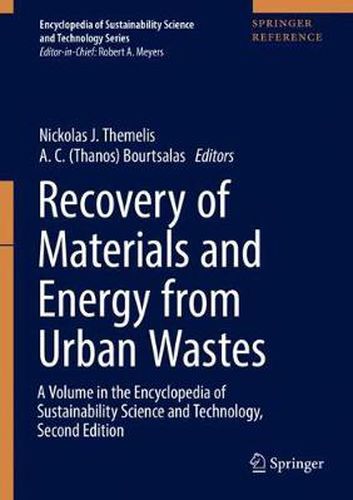Readings Newsletter
Become a Readings Member to make your shopping experience even easier.
Sign in or sign up for free!
You’re not far away from qualifying for FREE standard shipping within Australia
You’ve qualified for FREE standard shipping within Australia
The cart is loading…






This volume in the Encyclopedia of Sustainability Science and Technology, Second edition, provides a comprehensive overview of complementary strategies for dealing with waste in and around urban areas: Waste-to-energy power plants (WTEs) and recycling. Chapters in this volume describe how these plants can be built within or near cities to transform the non-recycled residues of society into electricity and heat, and the recovery of metals using recycling technology and management techniques. The latter includes resource recovery from construction and demolition and electronic waste streams.
With nearly one thousand WTE plants worldwide, waste incineration has become increasingly important as a means of closing the materials life- cycle loop. China leads in the beneficial use of these residues with about 30 new WTEs built in each of the last three years, and with plans for at least another 300 with one or more in each large city. In addition, increasing numbers of cement plants use waste materials as alternative fuels. Since currently all of these plants combust less than 20% of the available wastes, and the remainder ends up in landfills or dumps, this sector represents a huge market in the making.This comprehensive reference is suitable for readers just entering the field, but also offers new insights for advanced researchers, industry experts, and decision makers.
$9.00 standard shipping within Australia
FREE standard shipping within Australia for orders over $100.00
Express & International shipping calculated at checkout
This volume in the Encyclopedia of Sustainability Science and Technology, Second edition, provides a comprehensive overview of complementary strategies for dealing with waste in and around urban areas: Waste-to-energy power plants (WTEs) and recycling. Chapters in this volume describe how these plants can be built within or near cities to transform the non-recycled residues of society into electricity and heat, and the recovery of metals using recycling technology and management techniques. The latter includes resource recovery from construction and demolition and electronic waste streams.
With nearly one thousand WTE plants worldwide, waste incineration has become increasingly important as a means of closing the materials life- cycle loop. China leads in the beneficial use of these residues with about 30 new WTEs built in each of the last three years, and with plans for at least another 300 with one or more in each large city. In addition, increasing numbers of cement plants use waste materials as alternative fuels. Since currently all of these plants combust less than 20% of the available wastes, and the remainder ends up in landfills or dumps, this sector represents a huge market in the making.This comprehensive reference is suitable for readers just entering the field, but also offers new insights for advanced researchers, industry experts, and decision makers.